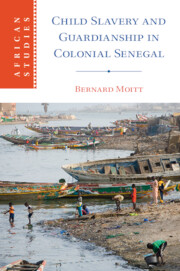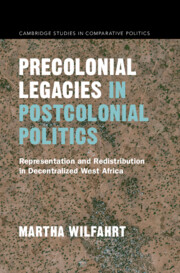Refine search
Actions for selected content:
156 results
Making Violators: Employers and African Workers in Colonial Dakar, 1918–43
-
- Journal:
- The Journal of African History / Volume 66 / 2025
- Published online by Cambridge University Press:
- 27 August 2025, e9
-
- Article
-
- You have access
- Open access
- HTML
- Export citation

The Undulating Capacity of the State
- Autochthony and Infrastructure Development in African Cities
-
- Published online:
- 11 August 2025
- Print publication:
- 04 September 2025
-
- Element
- Export citation
1 - Hierarchy, Community, and Nonviolence in Senegal
-
- Book:
- Pacifism and Non-Violence in Contemporary Islamic Philosophy
- Published online:
- 13 March 2025
- Print publication:
- 20 March 2025, pp 24-53
-
- Chapter
-
- You have access
- Open access
- HTML
- Export citation
Health Care Financing Instruments during the Colonial Period in Senegal: The Historical and Institutional Nature of Policy Instruments
-
- Journal:
- Journal of Policy History / Volume 37 / Issue 2 / April 2025
- Published online by Cambridge University Press:
- 10 March 2025, pp. 160-177
-
- Article
- Export citation
8 - Conclusion
-
- Book:
- The Financial Statecraft of Borrowers
- Published online:
- 12 December 2024
- Print publication:
- 19 December 2024, pp 268-292
-
- Chapter
- Export citation
Women, Kinship, and Intimacy in the Atlantic World - Wicked Flesh: Black Women, Intimacy, and Freedom in the Atlantic World Jessica Marie Johnson. Philadelphia: University of Pennsylvania Press, 2020. Pp. 328. $34.95, hardcover (ISBN:9780812252385); $24.95, paperback (ISBN: 9781512823707); $24.95, ebook (ISBN: 9780812297249).
-
- Journal:
- The Journal of African History / Volume 65 / Issue 1 / March 2024
- Published online by Cambridge University Press:
- 18 September 2024, pp. 138-140
-
- Article
- Export citation
7 - Iran and West Africa
- from Part II - Forming an Africa Policy (1971–1975)
-
- Book:
- Pahlavi Iran's Relations with Africa
- Published online:
- 13 June 2024
- Print publication:
- 27 June 2024, pp 175-202
-
- Chapter
- Export citation
First insights into the spatio-temporal ecology of sympatric large carnivores in Niokolo-Koba National Park, Senegal
-
- Article
-
- You have access
- Open access
- HTML
- Export citation
The within-country distribution of brain drain and brain gain effects: A case study on Senegal
-
- Journal:
- Journal of Demographic Economics / Volume 90 / Issue 3 / September 2024
- Published online by Cambridge University Press:
- 13 February 2024, pp. 384-411
-
- Article
- Export citation
Intellectuals with Pickaxes - A Ritual Geology: Gold and Subterranean Knowledge in Savanna West Africa By Robyn d'Avignon. Durham, NC: Duke University Press, 2022. Pp. 328. $104.95, hardcover (ISBN: 9781478015833); $27.85, paperback (ISBN: 9781478018476).
-
- Journal:
- The Journal of African History / Volume 64 / Issue 3 / November 2023
- Published online by Cambridge University Press:
- 01 February 2024, pp. 467-469
-
- Article
- Export citation
Crystallochemical characterization of the palygorskite and sepiolite from the Allou Kagne deposit, Senegal
-
- Journal:
- Clays and Clay Minerals / Volume 55 / Issue 6 / December 2007
- Published online by Cambridge University Press:
- 01 January 2024, pp. 606-617
-
- Article
- Export citation

Child Slavery and Guardianship in Colonial Senegal
-
- Published online:
- 19 October 2023
- Print publication:
- 02 November 2023
2 - Reinventions of Empire in the Nineteenth Century
-
- Book:
- French Colonialism
- Published online:
- 23 June 2023
- Print publication:
- 06 July 2023, pp 38-71
-
- Chapter
- Export citation
Local contextual factors of child stunting found via shared values of stakeholder groups: an exploratory case study in Kaffrine, Senegal
-
- Journal:
- Public Health Nutrition / Volume 26 / Issue 11 / November 2023
- Published online by Cambridge University Press:
- 08 June 2023, pp. 2418-2432
-
- Article
-
- You have access
- Open access
- HTML
- Export citation
Profiting from Slavery and Emancipation: Compensation, Capital, and Collateral in Nineteenth-Century Senegal
-
- Journal:
- Business History Review / Volume 97 / Issue 2 / Summer 2023
- Published online by Cambridge University Press:
- 01 June 2023, pp. 335-361
- Print publication:
- Summer 2023
-
- Article
-
- You have access
- Open access
- HTML
- Export citation
Synergies and Trade-offs Between the Food Policy Objectives: Evidence from the Dairy Sector of Senegal
-
- Journal:
- Journal of Agricultural and Applied Economics / Volume 55 / Issue 1 / February 2023
- Published online by Cambridge University Press:
- 24 April 2023, pp. 100-116
-
- Article
-
- You have access
- Open access
- HTML
- Export citation
The Management of the Bank of Senegal and the Formation of a Colonial Economy, 1840s–1901
-
- Journal:
- African Studies Review / Volume 66 / Issue 3 / September 2023
- Published online by Cambridge University Press:
- 22 March 2023, pp. 595-617
-
- Article
-
- You have access
- Open access
- HTML
- Export citation
Introduction
-
- Book:
- Precolonial Legacies in Postcolonial Politics
- Published online:
- 14 October 2022
- Print publication:
- 22 December 2022, pp 1-21
-
- Chapter
-
- You have access
- Open access
- HTML
- Export citation
The Muridiyya Diaspora - Muridiyya on the Move: Islam, Migration, and Place Making By Cheikh Babou. Athens: Ohio University Press, 2021. Pp. 326. $80.00, hardcover (ISBN: 9780821424377); $36.95, paperback (ISBN: 9780821424674); e-book (ISBN: 9780821447291).
-
- Journal:
- The Journal of African History / Volume 63 / Issue 3 / November 2022
- Published online by Cambridge University Press:
- 02 December 2022, pp. 434-436
-
- Article
- Export citation

Precolonial Legacies in Postcolonial Politics
- Representation and Redistribution in Decentralized West Africa
-
- Published online:
- 14 October 2022
- Print publication:
- 22 December 2022
-
- Book
-
- You have access
- Open access
- Export citation
